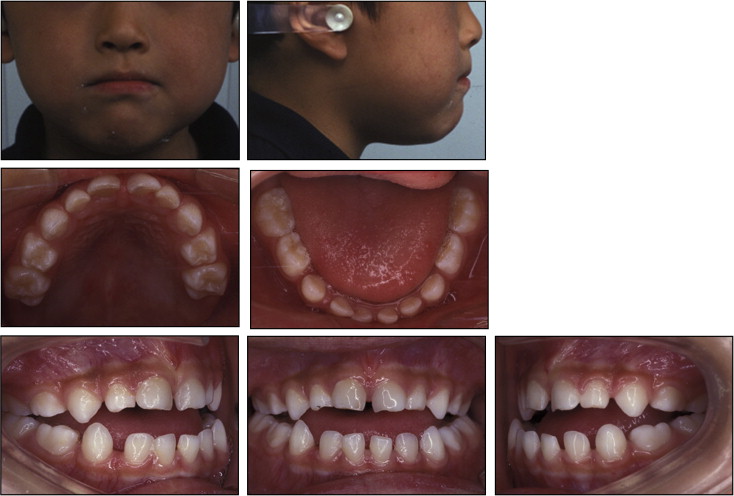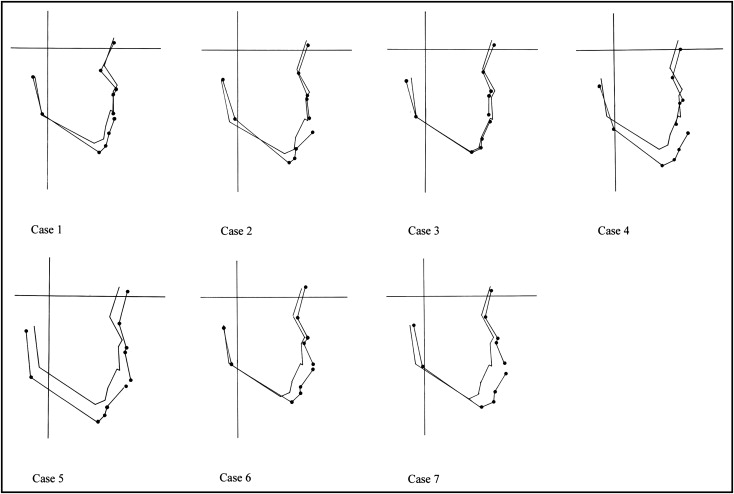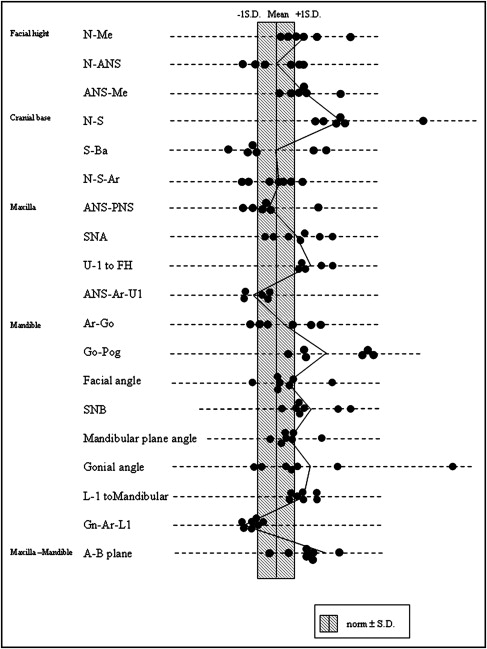Introduction
Beckwith-Wiedemann syndrome (BWS) is a genetic disorder characterized by exomphalos, macroglossia and gigantism. Previous studies reported a wide variation in the skeletal and occlusal characteristics in individuals affected by BWS. However, these studies were performed by analyzing both individuals who had and those had not received a glossectomy, which has a high impact on the jaw growth and occlusion. To highlight the intrinsic characteristics of BWS, 7 Japanese affected individuals without glossectomy were analyzed in this study.
Methods
Seven individuals who had been diagnosed with BWS by medical specialists and had not undergone glossectomy were analyzed. Cephalograms and dental casts were taken and systemic complications were recorded at the first visit.
Results
Individuals uniformly showed a higher birth height and weight, macroglossia, large anterior cranial base, and mandibular body. They exhibited a wide dental arch and an anterior open bite due to the undererupted and proclined anterior teeth. A wide variation was seen in the gonial angle, but the facial height was large overall.
Conclusions
As intrinsic characteristics of BWS, individuals exhibited macroglossia resulting in an anterior open bite and a wide dental arch. A long facial height and an enlarged anterior cranial base and mandibular body were also noted.
Beckwith-Wiedemann syndrome (BWS) (MIM 130650) was reported by Beckwith and Wiedemann. Beckwith reported 3 unrelated children with exomphalos (an umbilical hernia at birth in which some abdominal organs push into the umbilical cord), macroglossia, hyperplasia of kidneys and pancreas, hypoglycemia, and adenocortical cytomegaly. Wiedemann independently reported siblings with exomphalos and macroglossia. BWS is a congenital disease classified as one of the overgrowth syndromes and its occurrence is known to be 1/13,700. Genes, such as IGF2, H19, p57KIP2, and LIT1 , in an imprinted genomic domain of 11p15 are associated with this disease. IGF2 and H19 are associated with cancer risk, and malignant tumors such as nephroblastoma, adrenal cortical carcinoma and hepatocellular carcinoma are frequently seen with this disease.
Macroglossia is a predominant oral characteristic and is suggested to have a close relation to the oral function and maxillofacial morphology. In many affected individuals, glossectomy is recommended to correct a swallowing and speech problem, chronic obstruction of the upper airway, and occlusion.
Studies report a high prevalence of open bite in individuals affected by BWS, but inconsistencies are also reported in the maxillofacial morphology. For instance, Masubuchi et al reported that an enlarged gonial angle and mandibular plane angle were uniformly seen in affected individuals. In contrast, another study reported that the large gonial angle or steep mandibular plane angle was not seen. Glossectomy is known to cause the reduction of mandibular length and width in animal studies. Thus, although there is variability in this disease, we speculated that the analyses including both individuals who had and those who had not undergone glossectomy might be one of the reason for inconsistencies among these studies. The aim of this study is to highlight the intrinsic characteristics and to discuss the complications of a series of 7 cases affected by BWS.
Material and methods
Seven Japanese individuals affected by BWS (2 male and 5 female) in our dental hospital were evaluated in this study. All 7 cases were diagnosed as BWS by medical specialists in multiple medical hospitals based on comprehensive and precise examination. Differential diagnosis was performed by the precise consideration on each case. Their ages at the first visit to our dental hospital ranged from 4 years 8 months to 9 years 2 months. Records on systemic conditions and complications—including birth height and weight, gestational week at birth, macroglossia, glossectomy, exomphalos, tumor, earlobe anomaly, and hemihypertrophy—were obtained by an inspection and an interview of patients and their parents. The present height, weigh,t and head circumference were measured at the first visit.
Cephalograms were obtained for all patients at the first visit, and the skeletal and dental characteristics were evaluated. Traditional cephalometric landmarks were used in this study. Each overbite was measured from cephalograms. Every measurement of cephalograms was performed by 1 experienced orthodontist (A.K.). To minimize error, each measurement was repeated at least twice. Every error in measurement was within ± 0.5° degree or 0.5 mm.
Cast models were also taken in all patients at the first visit, and dental arch width and length were measured by caliper (type N•N-W, Mitutoyo, Tokyo, Japan), which had ± 0.05-mm error. The dental arch width, the distance between the tips of buccal cusps of the right and left teeth (deciduous canine and first and second molars, were measured in both arches. The dental arch length, the distance from the contact point of deciduous central incisors to the line connecting the distal surfaces of the right and left deciduous second molars, were measured in both arches. Every measurement of cast models was performed by 1 experienced orthodontist (T.S.). To minimize error, each measurement was repeated at least twice. Every error in measurements was within ± 0.5 mm.
The following norms were used in this study. Since individuals affected by BWS tend to be born prematurely, the birth height and weight of the study individuals were evaluated by the norm at the corresponding gestational week of Japanese infants who had normal or preterm birth, as reported by The Ministry of Health, Labor and Welfare. Norms of the height and weight of Japanese students were reported by The Ministry of Education, Culture, Sports, Science and Technology; the norm of the Japanese head circumference by Ishikawa et al ; the Japanese norms of N-Me, N-ANS, ANS-Me, N-S, S-Ba, ANS-PNS, Ar-Go, and Go-Pog by Masaki ; the Japanese norms of SNA angle, U1 to FH, facial angle, SNB angle, mandibular plane angle, gonial angle, L1 to mandibular plane, and A-B plane angle by Iizuka ; the Japanese norms of ANS-Ar-U1 and Gn-Ar-L1 by Kamiyama , and the norm of N-S-Ar reported by Björk. The norms of Japanese dental arch width and length were reported by Otsubo et al.
Results
Systemic condition and complications in 7 individuals affected by BWS
The birth height was more than 1 SD higher than the Japanese week- and gestational week–matched norm in all 5 individuals who had that record (cases 1, 2, 3, 4, and 6) ( Table I ). Among them, 2 (cases 2 and 6) were more than 2 SD higher than the norm. The birth weight was more than 1 SD higher than the Japanese sex– and gestational week–norm in all 7 individuals. Among them, case 2 was more than 2 SD higher and cases 1, 4, 5, and 7 were more than 3 SD higher than the norm.
| Case 1 | Case 2 | Case 3 | Case 4 | Case 5 | Case 6 | Case 7 | |
|---|---|---|---|---|---|---|---|
| Sex | M | M | F | F | F | F | F |
| Fetal age at birth (week) | 40 | 41 | 35 | 34 | 39 | 39 | 38 |
| Birth height (cm) | 52.3 (1.50) | 55.0 (2.26) | 46.8 (1.02) | 48 (1.81) | Unknown | 53 (2.59) | Unknown |
| Birth weight (g) | 4,155 (3.13) | 4,080 (2.26) | 2,740 (1.65) | 2,735 (3.09) | 4,400 (3.85) | 3,612 (1.92) | 4,080 (3.87) |
| Present age (years) | 4.8 years | 8.6 years | 6.3 years | 6.8 years | 7.5 years | 8.5 years | 9.2 years |
| Present height (cm) | 105.1 (–1.18) | Unknown | 115.3 (–0.08) | 125.5 (2.01) | Unknown | 122 (–0.98) | Unknown |
| Present weight (kg) | 17.0 (–0.77) | Unknown | 23.2 (0.63) | 31.0 (2.93) | Unknown | 23.8 (0.05) | Unknown |
| Present head circumference (cm) | 50.0 (–0.50) | 52.5 (0.42) | 51.0 (0.39) | 51.0 (0.39) | 54.2 (2.62) | Unknown | Unknown |
| Macroglossia | + | + | + | + | + | + | + |
| Exomphalos | − | + | + | + | − | + | − |
| Tumor | − | − | − | − | + | − | + |
| Earlobe anomaly | − | + | − | + | − | Unknown | − |
| Hemihypertrophy | + | − | + | − | − | + | − |
The present height and weight were more than 2 SD higher than the Japanese sex- and age-matched norm in 1 (case 4) of 4 individuals on record ( Table I ). The remaining 3 individuals were not higher than the norm. It was noted that most individuals who had high values in the birth height and weight became comparable to the Japanese norm; the exception was case 4.
The present head circumference was large in case 5 ( z score, 2.62), but those of the remaining 4 individuals on record were comparable to the sex- and age-matched norm ( Table I ). Macroglossia was seen in all 7 cases. Exomphalos, tumor, earlobe abnormality, and hemihypertrophy were present in 4, 2, 2, and 3 cases, respectively. In 3 hemihypertrophy cases, tongues were not asymmetrical.
Skeletal characteristics of 7 affected individuals
Like case 1 ( Fig 1 ), all 7 individuals showed an anterior open bite ( Fig 2 ). The apparent mandibular prognathism was seen in cases 1, 4, 6, and 7 ( Fig 2 ). Case 1 exhibited typical features of this disease, such as long face, macroglossia, open bite and spaced arch. Because of the macroglossia, the lingual cusps of the mandibular molars were hardly seen ( Fig 1 ). The cephalometric measurements of the 7 individuals are summarized in Table II and Fig 3 . The total (N-Me) and lower (ANS-Me) facial height was more than 1 SD higher in 4 of 6 patients who could be evaluated by the Japanese norm ( Table II , Fig 3 ). However, N-ANS varied among cases. The anterior cranial base (N-S) was more than 2 SD higher in 6 individuals who could be evaluated (cases 2 to 7) ( Table II , Figs 2 and 3 ). Values of S-Ba and the saddle angle (N-S-Ar) varied among cases ( Table II , Fig. 3 ).


| Case 1 | Case 2 | Case 3 | Case 4 | Case 5 | Case 6 | Case 7 | |
|---|---|---|---|---|---|---|---|
| Facial height | |||||||
| N-Me (mm) | 105.9 (ne) |
113.1 (0.79) |
105.3 (0.13)* |
114.4 (2.40)* |
121.1 (4.12) |
113.8 (1.39) |
114.1 (1.03) |
| N-ANS (mm) | 45.3 (ne) |
47.5 (–0.69) |
44.2 (–1.1)* |
50.1 (1.46)* |
49.6 (1.21) |
50.1 (0.92) |
46.7 (–1.79) |
| ANS-Me (mm) | 63.3 (ne) |
66.9 (1.19) |
62.1 (0.27)* |
67.3 (1.59)* |
75.0 (3.70) |
65.7 (0.86) |
69.6 (1.56) |
| Cranial base | |||||||
| N-S (mm) | 62.6 (ne) |
65.2 (2.61) |
64.2 (3.36)* |
64.9 (3.87)* |
71.6 (8.08) |
67.2 (3.68) |
65.3 (2.11) |
| S-Ba (mm) | 41.4 (ne) |
45.5 (–1.47) |
41.9 (–2.68)* |
51.5 (2.89)* |
50.0 (2.11) |
44.6 (–1.13) |
47.5 (–1.05) |
| N-S-Ar (°) | 124 (0.2) |
125 (0.4) |
127 (0.8) |
113 (–2.0) |
129 (1.2) |
121 (–0.4) |
114 (–1.8) |
| Maxilla | |||||||
| ANS-PNS (mm) | 47.3 (ne) |
44.4 (–1.89) |
46 (–0.83)* |
46.5 (–0.55)* |
51.7 (2.32) |
46.8 (–1.03) |
48.5 (–0.38) |
| SNA (°) | 84 (1.14) |
85 (1.33) |
80.9 (–0.16) |
88.5 (2.17) |
84 (0.80) |
79.3 (–0.63) |
90.4 (3.09) |
| U-1 to FH (°) | 105.5 (1.37) |
117.4 (1.44) |
nm | nm | 116.5 (1.26) |
128.3 (2.60) |
126.4 (3.16) |
| ANS-Ar-U1 (°) | 16.5 (–0.41) |
14.2 (–1.80) |
nm | nm | 16.3 (–0.54) |
16.0 (–0.72) |
14.02 (–1.88) |
| Mandible | |||||||
| Ar-Go (mm) | 38.7 (ne) |
37.5 (–0.90) |
37.8 (0.96)* |
44.5 (2.36)* |
43.4 (1.91) |
37.1 (–1.36) |
39.7 (–0.56) |
| Go-Pog (mm) | 65.7 (ne) |
67.4 (0.61) |
66.3 (1.41)* |
66.2 (1.37)* |
75.3 (4.8) |
74.0 (4.06) |
77.3 (4.30) |
| Facial angle (°) | 85.4 (0.28) |
83.2 (0.02) |
83 (0.03) |
86 (0.68) |
80.1 (–1.09) |
86.9 (0.95) |
90.9 (3.08) |
| SNB (°) | 81.7 (1.63) |
79.5 (1.18) |
78.8 (1.16) |
88.5 (4.25) |
76.7 (0.17) |
79.3 (1.07) |
87.1 (3.86) |
| Mandibular plane angle (°) | 32.4 (0.85) |
38.2 (2.59) |
31.6 (0.09) |
36.4 (0.97) |
32.8 (0.26) |
29.9 (–0.31) |
33.3 (0.55) |
| Gonial angle (°) | 134.8 (0.92) |
143.3 (3.03) |
135.4 (1.14) |
142 (9.41) |
129 (–0.90) |
128.8 (–1.06) |
132.3 (0.67) |
| L-1 to mandibular plane (°) | 90.6 (1.19) |
102.4 (1.45) |
93.2 (1.42) |
94.5 (0.77) |
104.6 (2.32) |
104.6 (2.32) |
98.9 (0.86) |
| Gn-Ar-L1 (°) | 20.42 (–1.15) |
20.71 (–1.00) |
19.42 (–1.70) |
19.98) (–1.39) |
20.36 (–1.18) |
20.99 (–0.83) |
19.46 (–1.68) |
| Maxilla-Mandible | |||||||
| ANB (°) | 2.3 (ne) |
5.5 (ne) |
2.1 (ne) |
0.0 (ne) |
7.3 (ne) |
0.0 (ne) |
3.3 (ne) |
| A-B plane (°) | −1.6 (1.70) |
−5.7 (0.56) |
−2.6 (1.92) |
2.04 (3.60) |
−7.3 (−0.24) |
−1.6 (2.11) |
−2.8 (1.84) |


Stay updated, free dental videos. Join our Telegram channel

VIDEdental - Online dental courses


